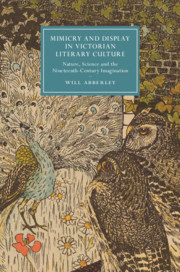 Mimicry and Display in Victorian Literary Culture
Mimicry and Display in Victorian Literary Culture Book contents
- Mimicry and Display in Victorian Literary Culture
- Cambridge Studies in Nineteenth-Century
- Mimicry and Display in Victorian Literary Culture
- Copyright page
- Contents
- Figures
- Acknowledgements
- Introduction
- Chapter 1 Seeing Things
- Chapter 2 Divine Displays
- Chapter 3 Criminal Chameleons
- Chapter 4 Darwin’s Little Ironies
- Chapter 5 Blending in and Standing out, I
- Chapter 6 Blending in and Standing out, II
- Conclusion
- Notes
- Bibliography
- Index
- Cambridge Studies in Nineteenth-Century Literature and Culture
Chapter 1 - Seeing Things
Art, Nature and Science in Representations of Crypsis
Published online by Cambridge University Press: 16 May 2020
- Mimicry and Display in Victorian Literary Culture
- Cambridge Studies in Nineteenth-Century
- Mimicry and Display in Victorian Literary Culture
- Copyright page
- Contents
- Figures
- Acknowledgements
- Introduction
- Chapter 1 Seeing Things
- Chapter 2 Divine Displays
- Chapter 3 Criminal Chameleons
- Chapter 4 Darwin’s Little Ironies
- Chapter 5 Blending in and Standing out, I
- Chapter 6 Blending in and Standing out, II
- Conclusion
- Notes
- Bibliography
- Index
- Cambridge Studies in Nineteenth-Century Literature and Culture
Summary
Chapter 1 argues that Victorian studies of animal mimicry and camouflage (known collectively as crypsis) resisted the hardening dichotomy between science and the arts. Researchers drew on their subjective perceptions, and art theories and techniques, to represent crypsis and recreate its illusions for readers. The first theorisers of ‘protective mimicry’, Henry Walter Bates and Alfred Russel Wallace, laced their writings with personal anecdotes of being deceived by animals’ appearances. Such narratives substituted for the imagined experiences of these animals’ predators and prey. It is proposed that these texts followed a pattern of perceptual self-scrutiny and suspended judgement that had been articulated by the art critic John Ruskin. Bates, Wallace and, even more, the Oxford zoologist Edward Bagnall Poulton also sought to simulate experiences of crypsis through illustrations. Accompanying text guided readers through the trompe l'oeil much as Ruskin’s ekphrastic prose guided the consumption of paintings. The tension between such artistic science and the rising ideal of objectivity came to a head in the controversial work of the American artist Abbott Handerson Thayer. Although Thayer made some lasting contributions to crypsis studies, his approach to nature as an artwork that only artists could understand provoked strong attacks from some zoologists.
- Type
- Chapter
- Information
- Mimicry and Display in Victorian Literary CultureNature, Science and the Nineteenth-Century Imagination, pp. 28 - 64Publisher: Cambridge University PressPrint publication year: 2020
